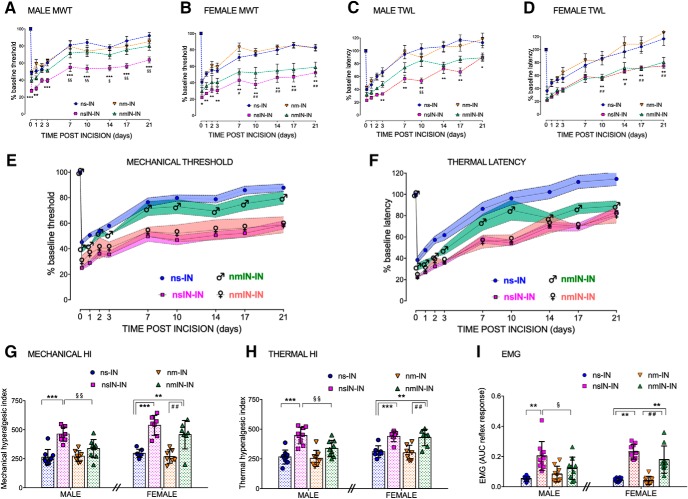Figure 2.
Mechanical and thermal hyperalgesia following adult reincision is sex-dependently influenced by minocycline at the time of neonatal incision. A–D, Changes in behavioral thresholds following incision are normalized as percentage change from baseline (adult preincision). Data points are mean ± SEM. n = 8 or 9 animals per group analyzed by two-way repeated-measures ANOVA with Bonferroni post hoc comparisons. Mechanical withdrawal threshold (MWT) in male (A) and female (B) rats and thermal withdrawal latency (TWL) in male (C) and female (D) rats are plotted against time points to 21 d after incision. Hyperalgesia is enhanced by prior incision (nsIN-IN vs nsIN: ***p < 0.001; **p < 0.01; *p < 0.05) in both males and females. A, In male rats, neonatal minocycline treatment significantly attenuated the enhanced mechanical hyperalgesia from 7 to 21 d (nmIN-IN vs nsIN-IN: §§p < 0.01; §p > 0.05). B, In female rats, mechanical hyperalgesia following reincision was enhanced 7–21 d following incision despite neonatal minocycline (nm-IN vs nmIN-IN: ##p < 0.01; #p < 0.05). Differences in thermal latency in males (C) and females (D) were less marked but followed the same overall pattern with neonatal minocycline attenuating reincision hyperalgesia in males but not females. E, F, Summary figures of mechanical (E) and thermal (F) hyperalgesia highlight sex-dependent differences following neonatal incision with minocycline (nmIN-IN). Within the ns-IN and nsIN-IN groups, data did not differ between males and females and are combined to minimize overlap in the figure. The impact of prior neonatal incision is highlighted by the clear separation in both the degree and duration of hyperalgesia (ns-IN vs nsIN-IN). In males, minocycline at the time of neonatal incision prevents adult reincision hyperalgesia (♂ nmIN-IN differs from nsIN-IN), and this group more closely approximates animals with no prior neonatal injury (ns-IN). In females, minocycline at the time of neonatal incision (♀ nmIN-IN) has no effect; enhanced adult reincision hyperalgesia persists, and this group approximates the nsIN-IN group. G, H, Behavioral data are expressed as the hyperalgesic index (area over the curve to 21 d after incision) of mechanical threshold (G) or thermal latency (H). Reincision hyperalgesia is apparent in males and females (nsIN vs nsIN-IN: ***p < 0.001; **p < 0.01) and is reduced by neonatal minocycline in males only (nsIN-IN vs nmIN-IN: §§p < 0.01). In females, enhanced reincision hyperalgesia persists despite minocycline (nmIN vs nmIN-IN: ##p < 0.01). Data points are individual animals (n = 8 or 9 per group). Error bars indicate mean ± SD analyzed by two-way ANOVA with Bonferroni post hoc comparisons. I, Reflex sensitivity 24 h following adult incision quantified as the area under the stimulus (hindpaw mechanical von Frey hair) versus response curve (electromyography recording biceps femoris; EMG area under curve reflex response) demonstrates reincision hyperalgesia in males and females (nsIN-IN>ns-IN: **p < 0.01). Neonatal minocycline (nmIN-IN) reduced the reincision response in males only (nmIN-IN < nsIN-IN: §p < 0.05), but enhanced hyperalgesia persisted in females (nmIN-IN > nsIN: **p < 0.001). Data points are individual animals (n = 9 or 10 per group). Error bars indicate mean ± SD analyzed by two-way ANOVA with sex and group as variables and Bonferroni post hoc comparisons. Groups include the following: ns-IN, nm-IN, nsIN-IN, and nmIN-IN.

